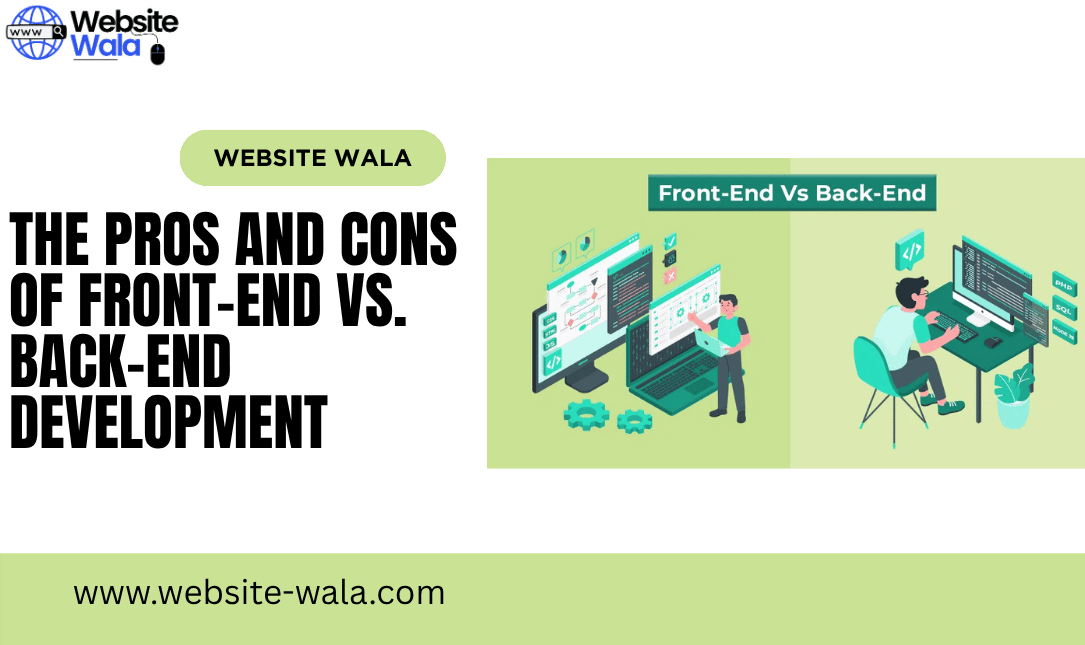
Discover The Pros and Cons of Front-End vs. Back-End Development and learn which path suits your career in web development and software development.
Introduction
In today’s rapidly evolving tech industry, the decision between front-end development and back-end development is crucial for anyone considering a career choice in web development or software development. Understanding The Pros and Cons of Front-End vs. Back-End Development can guide aspiring developers in choosing the path that aligns with their technology skills, interests, and professional goals. This article explores the advantages and disadvantages of both domains, helping you make informed decision-making choices about your career.
What is Front-End Development?
Front-end development refers to the client-side portion of web development that users directly interact with. It encompasses everything visible on a website, including web design, user interface (UI) elements, and responsive design. Front-end developers rely on front-end technologies like HTML, CSS, JavaScript, React, and Angular to create visually appealing and interactive experiences.
The main goal of front-end development is to ensure that websites and applications are not only functional but also engaging and intuitive for users. This requires a blend of coding, design aesthetics, and technical knowledge.
What is Back-End Development?
Back-end development, on the other hand, focuses on the server-side of a website or application. Back-end developers handle databases, server configurations, and application logic using back-end technologies like Python, Node.js, Ruby on Rails, Java, and PHP.
While front-end developers create what users see, back-end developers ensure that the server-side functions operate efficiently, securely, and reliably. They are responsible for data management, authentication, and integration with third-party services.
Key Differences: Front-End vs Back-End
When comparing front-end vs back-end, it’s essential to understand how they complement each other.
| Aspect | Front-End Development | Back-End Development |
|---|---|---|
| Focus | Client-side interface | Server-side functionality |
| Skills | HTML, CSS, JavaScript, UI/UX | Python, Java, Node.js, Databases |
| Goal | Enhance user experience | Ensure data processing and server logic |
| Tools | React, Angular, Vue | Django, Express.js, Ruby on Rails |
| Visibility | Visible to users | Hidden from users |
| Challenges | Cross-browser compatibility, responsive design | Security, scalability, database optimization |
This table highlights the distinctions and helps developers make an informed decision-making choice based on their technology skills and interests.
The Pros of Front-End Development
Focusing on front-end development offers several advantages:
-
Immediate Visual Impact: Front-end work is highly visible, allowing developers to see the results of their coding in real-time, which is rewarding and motivating.
-
Creative Expression: Front-end developers often engage in web design, crafting user interface elements and responsive design to enhance the user experience.
-
High Demand in the Tech Industry: With the growing importance of user experience, skilled front-end developers are increasingly sought after.
-
Versatility: Front-end technologies are evolving rapidly, providing opportunities to work on mobile apps, progressive web apps, and interactive websites.
The Cons of Front-End Development
Despite its advantages, front-end development has some disadvantages:
-
Frequent Changes in Technology: Front-end technologies evolve rapidly, requiring developers to continuously learn new frameworks and tools.
-
Browser Compatibility Issues: Ensuring that applications work across multiple browsers and devices can be challenging.
-
Less Focus on Logic: For those who enjoy deep programming or server-side work, front-end might feel limiting.
The Pros of Back-End Development
Back-end development offers distinct advantages in software development careers:
-
Strong Focus on Programming: Back-end work emphasizes coding and problem-solving skills, which is ideal for developers who enjoy technical challenges.
-
Critical Role in Web Applications: Back-end developers manage databases, authentication, and server-side logic that powers websites and apps.
-
Stability and Scalability: Back-end systems provide long-term reliability for applications, a key factor for enterprise projects.
-
High Demand: Companies need skilled back-end developers to ensure data integrity, security, and efficient web development.
The Cons of Back-End Development
However, back-end development comes with some disadvantages:
-
Less Visible Output: Unlike front-end work, back-end efforts are not directly visible to users, which can be less immediately rewarding.
-
Complex Problem-Solving: Managing databases, server loads, and integrations requires a higher level of technical expertise.
-
Limited Creativity: Back-end development is less focused on web design or user interface, which may not appeal to visually creative developers.
Making the Career Choice: Front-End vs Back-End
Choosing between front-end and back-end development depends on your personal strengths and interests:
-
If you enjoy designing user interfaces, responsive design, and seeing your work immediately impact users, front-end development might be the right choice.
-
If you prefer programming, handling server-side logic, and solving complex technical challenges, back-end development offers a rewarding path.
For those undecided, full-stack development—combining both front-end and back-end—is also an option, offering versatility and broader career opportunities in web development and software development.
Essential Technology Skills for Both Paths
Regardless of the path you choose, mastering the right technology skills is vital:
-
Front-end technologies: HTML, CSS, JavaScript, React, Angular, Vue, responsive frameworks.
-
Back-end technologies: Python, Node.js, Ruby on Rails, PHP, databases (SQL, NoSQL), API integration.
-
General skills: Version control, debugging, coding best practices, problem-solving, and familiarity with full-stack concepts.
Continuous learning is key in the tech industry, as both front-end and back-end roles evolve with emerging technologies.
Conclusion
Understanding The Pros and Cons of Front-End vs. Back-End Development is essential for anyone aiming to enter web development or software development. Each path has unique advantages and disadvantages, from creative, visible work in front-end development to technical, server-side problem-solving in back-end development.
By assessing your technology skills, preferences, and career goals, you can make an informed decision-making choice that aligns with your aspirations. Whether you choose front-end, back-end, or full-stack development, mastering the required programming and coding skills will set you on a successful path in the tech industry.























